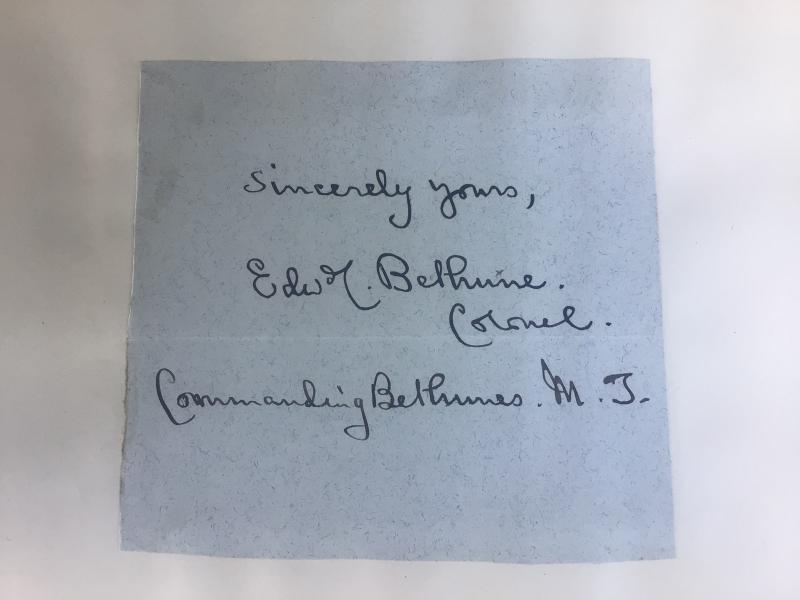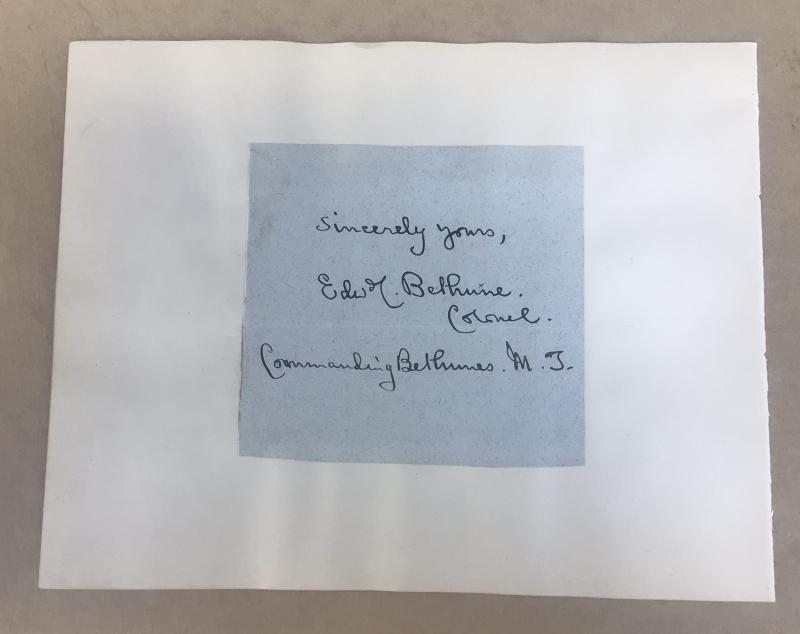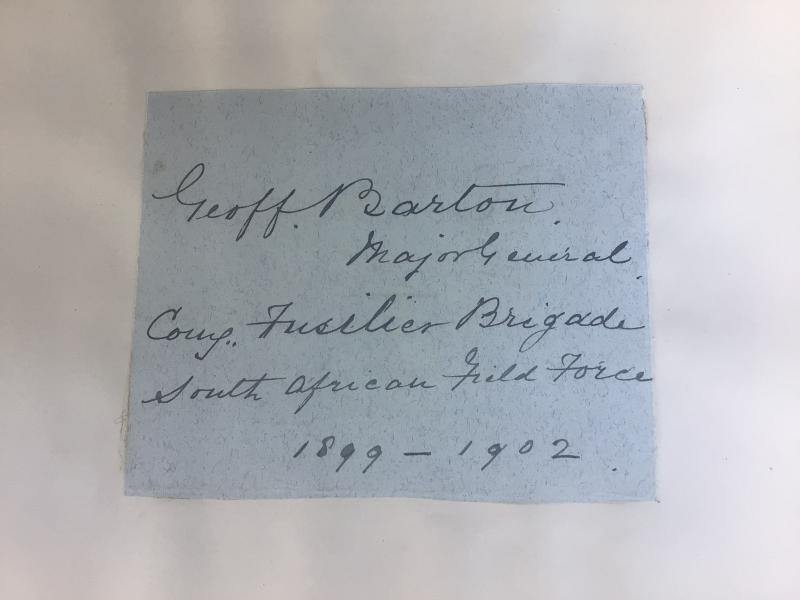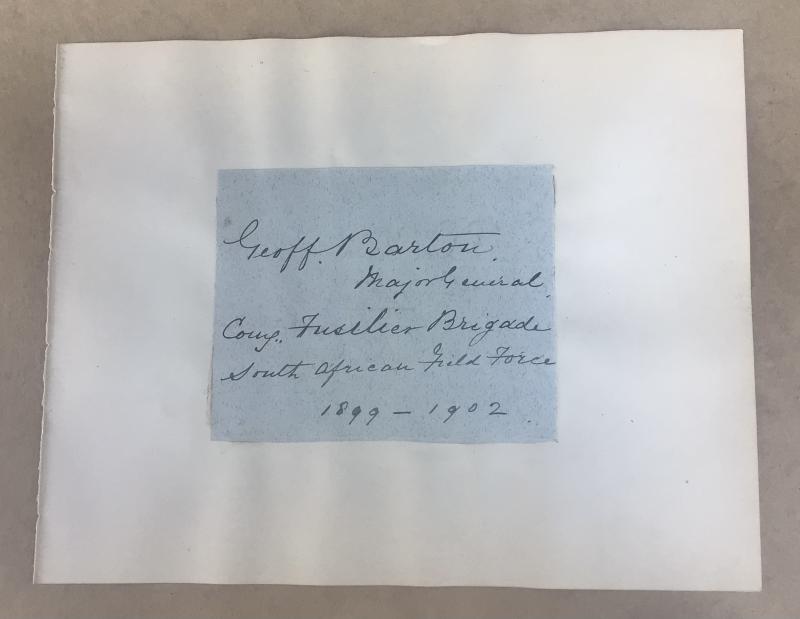Boer War Signatures - Lieutenant General Sir Edward Cecil Bethune (BMI)
Lieutenant General Sir Edward Cecil Bethune, KCB, CVO (23 June 1855 – 2 November 1930) was a British Army officer who raised and led his own regiment, Bethune's Mounted Infantry, in the Second Boer War and directed the Territorials in the First World War. At the age of 20 he gained a commission in the 92nd (Gordon Highlanders) Regiment of Foot in September 1875, seeing service in the Second Anglo-Afghan War in Afghanistan from 1878 to 1880, where he was present in the operations around Kabul in December 1879. He served with his regiment in the First Boer War in South Africa from 1880 to 1881, and was promoted to captain on 1 February 1884. In 1886, he transferred to a cavalry regiment, the 6th Dragoon Guards. Posted again to South Africa in September 1899, on the outbreak of the Second Boer War, he raised and commanded Bethune's Mounted Infantry, receiving the rank of lieutenant colonel on 29 September 1900. His unit fought at the battles of Colenso and Spion Kop, and took part in the relief of Ladysmith. In late 1900 he was recalled to the 16th Lancers as a brevet colonel, becoming their commanding officer and heading a cavalry brigade. Then he was moved to staff work, acting as Assistant Adjutant-General of the Field Force in South Africa. He was mentioned in despatches three times (including in the final despatch by Lord Kitchener dated 23 June 1902).The war over, he was promoted to brigadier general in 1905, placed on the General Staff, and appointed in command of the Eastern Sub-District of the Cape Colony. He was appointed a Companion of the Order of the Bath (CB) in the 1905 Birthday Honours.
On the reverse side. General Sir Geoffrey Barton At the outbreak of the Second Boer War, Major General Barton joined General Sir Redvers Buller's Natal Field Force in command of the 6th (Fusiliers) Brigade (often referred to by Sir Winston Churchill as "Barton's Brigade" in his book From London to Ladysmith via Pretoria.
Buller's first objective was the Relief of Ladysmith, to which end he moved his army up from Cape Town via Pietermaritzburg to Frere, just south of the Tugela River, the north of which the Boers had placed their defensive line. During the first attempt to cross the Tugela at the Battle of Colenso, Barton's Brigade were in reserve but when the attackers were forced to withdraw, Barton cautiously chose not to send support.
Next, Buller tried to turn the Boers' right flank by sending the bulk of his army to the west and attacking Spion Kop whilst Barton was left to entrench at Chieveley to protect the head of the communications line. A third attempt to cross the Tugela at Vaal Krantz also failed.
The Battle of the Tugela Heights was a series of battles fought initially to the south but then across the north banks of the Tugela river. Once Hussar Hill had been captured by Dundonald's Mounted Brigade and Lyttelton's 4th Infantry Division had taken Cingolo Hill, Barton's brigade moved to capture Green Hill whilst Hildyard's Brigade captured the height of Monte Cristo. On 27 February, Barton's Brigade attacked Pieters Hill behind a creeping artillery barrage and was rapid at first until they moved out of observation range of the field artillery and the Boers having reinforced, the attack stalled. Fortunately for the British, the rest of the general movement was taking its toll on the Boers and they were forced to abandon the heights, clearing the way for the relief of Ladysmith on 1 March. Barton was injured during the action on 27 February.
After Ladysmith and Mafeking had been relieved, Major General Barton was sent to the Weston Transvaal, where he commanded in the Krugersdorp and Pretoria districts until the end of the war in early June 1902. He left Cape Town on the SS Canada and returned to Southampton in late July 1902.
For his service in the war, he was mentioned in despatches (including by Lord Kitchener dated 23 June 1902 and appointed a Companion of the Order of St Michael and St George (CMG).
Both signatures cut from letter correspondence and glued onto a piece of paper approx ( removed from an autograph album). Approx 225x180mm.
Code: 1844
100.00 AUD




